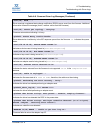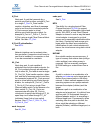
FC0054607-00 A Glossary-5
Fibre Channel and Converged Network Adapters for VMware ESX/ESXi 4.0
User’s Guide
N_Port
Node port. A port that connects by a
point-to-point link to either a single N_Port
or a single F_Port. N_Ports handle
creation, detection, and flow of message
units to and from the connected systems.
N_Ports are end ports in virtual
point-to-point links through a fabric, for
example N_Port to F_Port to F_Port to
N_Port using a single Fibre Channel fabric
switch. See also FL_Port.
N_Port ID virtualization
See NPIV.
NIC
Network interface card or network inter-
face controller. A computer circuit board or
card that is installed in a computer so that
it can be connected to a network.
NL_Port
Node loop port. A port capable of
arbitrated loop functions and protocols. An
NL_Port connects through an arbitrated
loop to other NL_Port and at most a single
FL_Port. NL_Ports handle creation, detec-
tion, and flow of message units to and from
the connected systems. NL_Ports are end
ports in virtual point-to-point links through
a fabric, for example NL_Port to F_Port to
F_Port to N_Port using a single Fibre
Channel fabric switch. In the absence of a
fabric switch FL_Port, NL_Ports can
communicate with other NL_Ports in
virtual point-to-point links through a FC_AL
open loop circuit often through FC_AL
(arbitrated Loop) hub or loop switch
devices. See: E_Port, F_Port, FL_Port,
G_Port, N_Port.
node loop port
See NL_Port.
node port
See N_Port.
NPIV
The ability for a single physical Fibre
Channel end point (N_Port) to support
multiple, uniquely addressable, logical end
points. With NPIV, a host Fibre Channel
Adapter is shared in such a way that each
virtual adapter is assigned to a virtual
server and is separately identifiable within
the fabric. Connectivity and access privi-
leges within the fabric are controlled by
identification of each virtual adapter and,
hence, the virtual server using each virtual
adapter.
NVRAM
Non-volatile random access memory. A
type of memory that retains data (configu-
ration settings) even when power is
removed. You can manually configure
NVRAM settings or restore them from a
file.
path
A path to a device is a combination of a
adapter port instance and a target port as
distinct from internal paths in the fabric
network. A fabric network appears to the
operating system as an opaque network
between the adapter (initiator) and the
target.
Because a path is a combination of an
adapter and a target port, it is distinct from
another path if it is accessed through a
different adapter and/or it is accessing a
different target port. Consequently, when
switching from one path to another, the
driver might be selecting a different
adapter (initiator), a different target port, or
both.


















